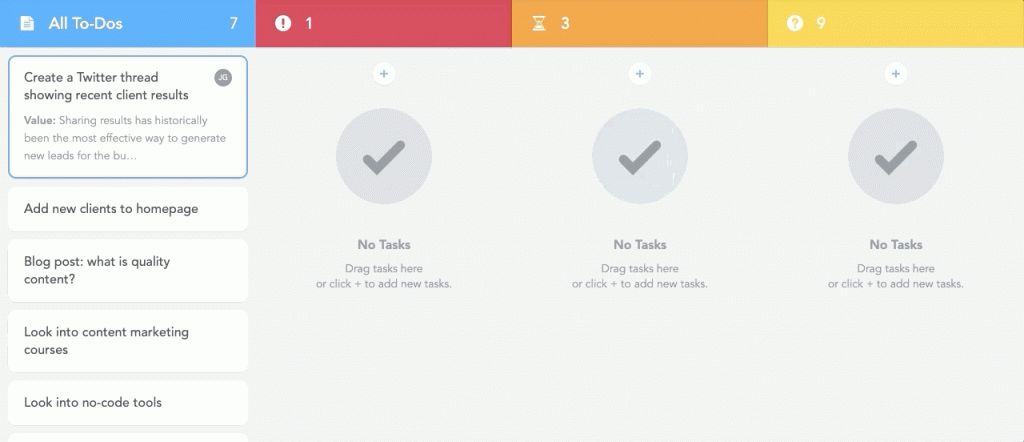What you presumably experienced was this: you arranged your day the prior night, and you believed you were on top of your undertakings. Notwithstanding, things began to turn out badly when you continued to add errands to your rundown, lastly, your assignment list was numerous miles long. Your daily agenda likewise contained assignments that were essentially difficult to finish in one day.
Plans for the day are an incredible method for monitoring remarkable undertakings, however they can be unfortunate inspirations. They frequently end up excessively lengthy, excessively short, excessively ambiguous, excessively confounding, overcommitted, clumsy, old and neglected, or even excessively fastidiously arranged. Try not to deal with your tasks. Finish them, less difficult assists you with focusing on the main priority so you can zero in on the main thing. Less complex merits your consideration. It works better compared to Todoist with regards to effortlessness. Keep doing awesome!”
![7 Ways to Write a Better To-Do List [2022]](https://gplfreetheme.com/wp-content/uploads/2022/08/SIMPLER-1024x515.jpg)
It doesn’t appear to be a confounded work on recording a couple of things you need to finish every day except so frequently it is.
On the off chance that you’ve viewed your easy plan for the day as everything except, utilize at least one of these seven procedures to make a superior daily agenda.

1. Note Why Each To-Do on Your List Is Important
For the overwhelming majority of us, plans for the day feel like shackles. They make us hopeless and sap our energy instead of persuading us to accomplish more.
Craftsmanship Markman, teacher of brain science and promoting at the College of Texas at Austin, says this is on the grounds that our plans for the day are again and again only assortments of exhausting, upsetting, or cliché assignments:
Assuming you stand up to yourself every day with tokens of just the most un-charming pieces of your work, it’ll presumably end up draining your inspiration to come to work.
Assuming that sounds like your plan for the day, Markman recommends an exceptionally basic arrangement: reevaluating your rundown to be engaged around your greater reason at work. Assuming that you interface the assignments on your daily agenda to your greater reason, they’ll feel less exhausting and commonplace and more significant and inspiring.
Consider adding a sentence to each errand on your plan for the day that makes sense of the benefit of finishing that job. On the off chance that you can plainly characterize why an undertaking should be finished, you’ll feel more spurred to finish it.
![7 Ways to Write a Better To-Do List [2022]](https://gplfreetheme.com/wp-content/uploads/2022/08/2.jpg)
2. Delete Low/No-Value Tasks and Nice-To-Dos
One more advantage of characterizing the worth of the assignments on your plan for the day: it assists you with finding the errands that most likely do not merit doing. In the event that you can’t sort out what worth finishing a responsibility will give, you ought to presumably erase it off of your rundown.
One of the most well-known issues with plans for the day is that they’re overpowering. At the point when you’re continually adding new tasks to your rundown as they jump into your head, you frequently end up with handfuls or many tasks.
Consistently, you need to parse through those things to choose what to zero in on straightaway. What’s more, consistently, the developing size of your rundown worries you. You might very well never traverse them all.
Erasing low-esteem, no-worth, and good to-take care of undertakings from your rundown assists you with making a superior plan for the day since it makes your rundown more reasonable, not so much distressing, but rather more skimmable. It keeps your most squeezing and significant errands top-of-brain and assists you with trying not to get occupied by undertakings that won’t make a definite difference.
Furthermore, assuming that you’re worried that you’ll forget about undertakings you may ultimately need to set aside a few minutes for by erasing them from your rundown, you can utilize an instrument like MeisterTask to move those tasks onto their own “sometime in the not so distant future” list that you can survey once in a while when you’ve run out of activities.
![7 Ways to Write a Better To-Do List [2022]](https://gplfreetheme.com/wp-content/uploads/2022/08/3.jpg)
This keeps your important and unimportant to-do lists separate but lets you keep track of the nice-to-dos you might want to tackle when work is slow.
3. Create a To-Do List for Each Week or Each Day
If you’ve deleted all of your no/low-value and nice-to-have tasks from your to-do list and still find it overwhelming, consider using one of the following prioritization techniques to create an individual to-do list for each week or day:
- MITs – Zen to Done’s Leo Babauta recommends starting each day by picking between one and three tasks you’ll focus on that day. These are your most important tasks (MITs), and you shouldn’t work on anything else until those tasks are complete.
- Ivy Lee Method – At the end of every workday, choose six tasks to focus on tomorrow, order them in priority from 1-6, and then work on those tasks in priority order the next day until all six tasks are complete.
- 1-3-9 – At the beginning of every workday, choose 13 tasks to focus on that day: one high-priority task, three medium-priority tasks, and nine low-priority tasks. Complete the high-priority task first, followed by the medium-priority tasks, and finally the low-priority tasks.
Contingent upon the size of your assignments, you can finish these activities toward the start of every day or start of every week. In the event that your errands require a couple of hours to finish, day to day ought to function admirably. On the off chance that you have for the most part multi-day errands, plan and focus on week by week.
While utilizing these strategies, it assists with having a plan for the day instrument that makes it simple to relocate your tasks into various paths. For instance, this is the way you could set up MeisterTask to turn out impeccably for the 1-3-9 technique.

4. Break Large To-Dos Down Into Smaller To-Dos
One of the quickest ways to get overwhelmed when looking at your to-do list is to have a list filled with monstrous tasks that will take weeks to complete.
Let’s say one of your tasks is “plan 2020 editorial calendar.” That’s a massive undertaking composed of many smaller tasks like:
- conduct keyword research
- conduct competitive research
- audit and catalog existing content
- review ideas backlog
- solicit ideas from customer service and sales
- ask customers for ideas
- evaluate all ideas
- create calendar
That’s weeks worth of work you’ve combined into a single to-do line item.
Instead of having lots of very large tasks on your lists, spend some time breaking those large tasks down into the smallest completable components.
![7 Ways to Write a Better To-Do List [2022]](https://gplfreetheme.com/wp-content/uploads/2022/08/5.jpg)
This will not only make it easier to plan your days and weeks, but it will also give you the satisfaction of seeing more completed items on your list, which should help motivate you to keep working your way through your list.
Break large tasks down easily with simpler

5. Write a “What I’ll Probably Do” List
Mark Forster, the writer of numerous efficiency books, when directed an efficiency explore where he composed his plan for the day for the afternoon and afterward set it aside in a cabinet. Forster trusted composing the rundown would be sufficient to cause him to recall what was on it and finish everything.
Tragically, when the day’s end moved around, Forster hauled the rundown out of its cabinet and acknowledged he hadn’t done even one errand on the rundown!
Pondering why the investigation fizzled, Forster concocted another methodology: the following day, he composed a rundown of what he figured he would really do. This was to a greater extent an expectation list rather than the sort of confident list of things to get the majority of us make for our day to day task records.
Once more, Forster set the rundown aside in the cabinet. Be that as it may, this time, he figured out how to finish each responsibility on the rundown — and all without taking a gander at it once!
According to the secret to this methodology, Forster, is making the rundown in reply to the inquiry:
What do I really believe that I will do today?
Posing that inquiry changes how you approach making a plan for the day for the afternoon. Rather than arranging in light of what you desire to achieve, you plan in view of what you accept you really will achieve, which assists you with making a superior, more reasonable arrangement.
Utilizing this methodology, Forster found he accomplished really during the day, yet he even figured out how to get past certain errands he’d been investing off for a long effort.
Assuming that you find your existence seldom matches the arrangement you make early, take a stab at making your plan for the day in reply to Forster’s inquiry and see what improvement it makes to your efficiency.
6. Make Your To-Do List Public
![7 Ways to Write a Better To-Do List [2022]](https://gplfreetheme.com/wp-content/uploads/2022/08/7.jpg)
While it may not be practical for every to-do list, another way to write a better to-do list is to make your list public so anyone can see it.
This is something software developer Joe Reddington did in 2016, saying “it’s been the most effective change in my productivity in at least two, possibly five years.”
Why did a public to-do list have such a big effect on Reddington’s productivity? It was all about how he wrote his to-do list.
As soon as he made the list public and realized other people could read it, Reddington saw things he’d overlooked when the list was private. He’d included duplicate tasks, written tasks as questions rather than statements he could act on, and had many poorly-written tasks on his list.
Reddington went over his list and rewrote many of his tasks, as well as deleting duplicates. The process of rewriting tasks so they made sense to other people, Reddington said, made him think about them carefully and define them better:
When you write a to-do item for someone else to read, you tell them what actually has to happen, but when you write it for yourself, you leave yourself a cryptic note.
Even if you don’t want to make your entire task list public, you can replicate the benefits of Reddington’s experiment by imagining that someone else will read your to-do list.
Writing your tasks as if they’re going to be read by someone else will force you to articulate and define them more clearly, making it easier and faster to act on them later.
7. Draw Your To-Do List
![7 Ways to Write a Better To-Do List [2022]](https://gplfreetheme.com/wp-content/uploads/2022/08/8.jpg)
Want to just remember what you need to do instead of having to refer to a list constantly? If so, you’ll probably have the best chance of remembering what you need to do if you draw your to-do list instead of just writing tasks down.
In a 2016 study, researchers gave people 40 seconds to either draw words or write them down repeatedly. After drawing/writing a variety of words, participants were asked to recall the words. Those who had drawn the words recalled more than twice as many words as those who wrote their words down.
The researchers believe the difference may be due to how many different skills we use when drawing. We have to imagine the item in our mind, think about its physical properties to figure out how to depict it in a drawing, and use our motor skills to draw it on the page.
The study’s authors say this combination may make us create a stronger memory of the word:
We believe that the benefit arises because drawing helps to create a more cohesive memory trace that better integrates visual, motor, and semantic information.
So if you find you’re not getting enough done because you forget what you’ve planned for the day—or you’re wasting time looking at your to-do list over and over during the day—try drawing it instead. You might be surprised at how much better you recall everything you wanted to get done.
If drawing isn’t your strong suit, you can also try using a mind mapping tool like simpler to create more visual to-do lists.
The visual nature of a mind map will help you create a picture in your mind of the things you need to get done, and you can also attach images to your mind map for even more visual cues to reference when you’re trying to remember what needs to be done.
Start Building a Better To-Do List
While the right strategies can unquestionably assist you with building a superior plan for the day, the right instruments can help, as well. In the event that you’re searching for a superior to-do device, consider utilizing less complex.
Mind-planning instrument less difficult makes it simple to make visual daily agendas, to conceptualize the errands you really want to do, and to separate huge assignments into more modest parts.
Then, at that point, with the less difficult, you can send your errands directly to task-the board instrument more straightforward where you can design your days utilizing MITs or 1-3-9 and offer your daily agenda with others.
With the right strategies and the right devices, you’ll be well en route to a superior plan for the day.
- How to Add a Reading Scroll Progress Bar to Your WordPress Site (Without a Plugin)

- Fix Your Missing H1 Tags in WordPress: A Beginner’s Guide to SEO Improvement

- The Easiest Way to Add Sticky Footer Ads on WordPress & Blogger in 2024

- How to Make Entire Block Clickable in GeneratePress?

- How to Make Last Widget Sticky in GeneratePress Theme [2024]

- How to Add a Sticky Mobile Footer Ad in GeneratePress (2024)

- How to Switch your WordPress Theme to GeneratePress in 2024
![How to Switch your WordPress Theme to GeneratePress [2024]](data:image/svg+xml;base64,PHN2ZyB4bWxucz0iaHR0cDovL3d3dy53My5vcmcvMjAwMC9zdmciIHdpZHRoPSIzMDAiIGhlaWdodD0iMTY5IiB2aWV3Qm94PSIwIDAgMzAwIDE2OSI+PHJlY3Qgd2lkdGg9IjEwMCUiIGhlaWdodD0iMTAwJSIgc3R5bGU9ImZpbGw6I2ZmZmZmZjtmaWxsLW9wYWNpdHk6IDAuMTsiLz48L3N2Zz4=)
- How to Create a Sticky Floating Sidebar in Astra Theme (2024 Tutorial)

- How to Make Sidebar Sticky in Kadence Theme? [2024]
![How to Make Sidebar Sticky in Kadence Theme [2024]](data:image/svg+xml;base64,PHN2ZyB4bWxucz0iaHR0cDovL3d3dy53My5vcmcvMjAwMC9zdmciIHdpZHRoPSIzMDAiIGhlaWdodD0iMTY5IiB2aWV3Qm94PSIwIDAgMzAwIDE2OSI+PHJlY3Qgd2lkdGg9IjEwMCUiIGhlaWdodD0iMTAwJSIgc3R5bGU9ImZpbGw6I2ZmZmZmZjtmaWxsLW9wYWNpdHk6IDAuMTsiLz48L3N2Zz4=)
![7 Ways to Write a Better To-Do List [2022]](https://gplfreetheme.com/wp-content/uploads/2022/08/TO-DO.jpg)






![How to Switch your WordPress Theme to GeneratePress [2024]](https://gplfreetheme.com/wp-content/uploads/2024/01/How-to-Switch-your-WordPress-Theme-to-GeneratePress-2024-2-300x169.webp)

![How to Make Sidebar Sticky in Kadence Theme [2024]](https://gplfreetheme.com/wp-content/uploads/2024/01/How-to-Make-Sidebar-Sticky-in-Kadence-Theme-2024-300x169.webp)